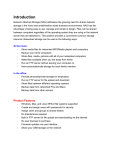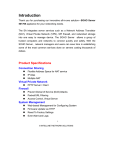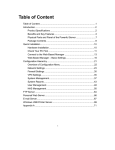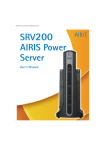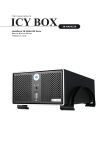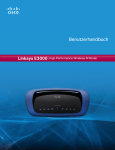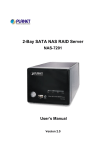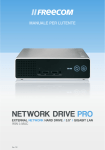Download Intellinet 524469 storage enclosure
Transcript
Gigabit SATA NAS 2TB user manual Model 524469 INT-524469-UM-1108-01 table of contents section page INTRODUCTION.................................................................................................... 3 HARDWARE/ INSTALLATION................................................................................ 5 Indicators & Connections.................................................................................. 6 QUICK INSTALLATION.......................................................................................... 7 Accessing the NAS........................................................................................... 7 Configuring the NAS........................................................................................11 CONFIGURATION................................................................................................ 13 Basic Settings................................................................................................. 13 System Management...................................................................................... 15 System Reports............................................................................................... 20 User Management........................................................................................... 21 NAS Management........................................................................................... 23 P2P Settings................................................................................................... 34 FTP SERVER....................................................................................................... 37 WINDOWS USB PRINTER SERVER................................................................... 38 UPnP SETTINGS................................................................................................. 39 APPENDIX A........................................................................................................ 40 SPECIFICATIONS.................................................................................................41 2 CONTENTS introduction Thank you for purchasing the INTELLINET NETWORK SOLUTIONS™ Gigabit SATA NAS 2TB, Model 524469. Addressing the growing needs for additional high-speed storage in the SOHO and small/medium-sized business environments, the Gigabit SATA NAS 2TB lets you install two SATA hard drives up to 1 Terabyte each for extremely fast access to data storage on your network. And if additional space is needed, you can connect two additional USB HDDs. The Gigabit SATA NAS 2TB supports RAID 0 and RAID 1 configurations: RAID 0 (striped disks) distributes data across both hard drives to improve speed and capacity — however, if one hard drive fails, the data is lost; Alternatively, RAID 1 (mirrored disks) is a backup solution using both hard drives to store the same information — if one hard drive fails, the information is not lost. With a Gigabit network connection, the SATA NAS 2TB provides ultrafast data throughput of up to 25 MB/s, making it the perfect network storage unit for smaller work groups. Plus, you can stream videos and photos through your Universal Plug and Play-enabled media player in your home entertainment center. Follow the instructions in this manual and you’ll also soon be enjoying the benefits of these additional features: • Gigabit Ethernet port for high-speed network connectivity • Supported USB hard drive file systems: FAT32, EXT2, EXT3, NTFS • Integrated iTunes Digital Audio Access Protocol (DAAP) server delivers audio streams to any iTunes-compatible media player on the network • Built-in FTP server allowing remote users to upload/download files • BitTorrent client to download files from the BT network while having your computer turned off • Cross-platform file sharing for Windows, Linux and Mac OS • Supported file serving protocols: CIFS (Samba), FTP, NFS and AFP • Supports 256 user accounts and user groups • Create up to 250 shared folders • User (name/password) and Sharing Level (read/write) security • Supports Self-Monitoring Analysis and Reporting Technology-enabled (SMART) hard drives INTRODUCTION 3 • Adjustable hard drive spin-down time • Self-repairing and de-fragmentation for data integrity and performance • Easy Web-based configuration via Web browser • Firmware update via Web browser and USB HDD • Lifetime Warranty NOTE: Some screen images are modified to fit the format of this manual. System Requirements • • • • For accessing files: Network adapter installed and functioning properly For PC configuration: Internet Explorer 5.5 and above or latest Opera browser with Java support For Mac configuration: Internet Explorer 5.2 or latest Opera browser with Java support For Linux configuration: Latest Opera browser with Java support Package Contents • Gigabit SATA NAS 2TB • Power adapter • Quick install guide • CD with user manual 4 INTRODUCTION hardware/installation To install a hard disk/drive in the Gigabit SATA NAS 2TB, follow the steps below. 1. Shut down the NAS and unplug the power cord from the AC outlet. 2.Remove the screws that secure the hard disk/drive cover to the side of the NAS device and slide the cover off. 3.Slide the hard drive/disk inside the cover you just removed from the NAS device. 4.Connect the SATA cable and hard disk/drive power cord between the hard disk/drive and the NAS. 5.Re-position the HDD/cover assembly onto the NAS, being careful not to crush (and possibly damage or disconnect) the SATA cable and HDD power cord. The hard disk/drive installation is now complete. Turn on the NAS. HARDWARE INSTALLATION 5 Indicators & Connections 1.Using Ethernet cable, connect the LAN (Ethernet) port to a PC, server, switch, hub or other network device on the LAN. 2.Connect the included power adapter to a surge protector. 3.If/when desired, connect the device port Reset (A or B) to an external USB hard drive. USB HDD B port 4.Turn on the power to the NAS. Reset Button USB HDD port LAN If you forget your password and/or unit IP address, you won’t be able to access the Power NAS. However, you can use the recessed DC 12V Reset button to restore factory settings. To initiate a reset, press and hold the button in (using a straight pin or similar object) for 5 seconds or more until the unit stops beeping. Power Button Press lightly once to turn the NAS on or off. The unit will write all data into the drive and safely power down. To force the unit to power down immediately, press and hold the button until the power is off. Front Panel LEDs LED Status Indication Power (not shownOn Power to the NAS is on at right) Off Power to the NAS is off HDD (A & B) / Data Flashing Attached HDD is reading/writing data LAN / 10/100On Network link is 10/100 Mbps Off Link is disconnected Flashing Transmitting/receiving data packets LAN / 1000On Network link is 1000 Mbps Off Link is disconnected Flashing Transmitting/receiving data packets 6 HARDWARE INSTALLATION quick installation Accessing the NAS mapping a shared folder Mapping your shared folder(s) to your computer makes accessing them easier. When a shared folder is mapped, it will appear as a drive letter (for example, “D:” or “E:”) on your computer. When you want to access that shared folder, you can simply go to My Computer and doubleclick on the drive letter. You can also have the computer log in to the shared folder at startup so you don’t need to manually do it each time. To map the NAS’s shared folder to a drive letter under My Computer: 1.Select “Map Network Drive” from the Tools menu. 2.Choose a drive letter to use to map your shared folder. Click “Browse” and locate the shared folder in Entire Network. Click “OK” once you’ve located the shared folder. QUICK INSTALLATION 7 3.Select “Reconnect at logon” so you don’t need to repeat this process. Click “Finish.” 4.You will now see the Share as a drive in My Computer. You can access it by double clicking on the drive. enabling UPnP UPnP (Universal Plug and Play) is only available in Windows XP, Me and Vista. Though not required, enabling it makes configuration easier. 1.Go to the Start menu; then Control Panel; then Add/Remove Programs. 2.Click “Add/Remove Windows Components” on the left-hand side to display the Windows Components Wizard screen. 8 QUICK INSTALLATION 3.Highlight “Network Services” and click “Details.” 4.Select “Universal Plug and Play” and click “OK.” 5.Select “Next” to continue. QUICK INSTALLATION 9 6.After all the components are installed, click “Finish.” You can access the configuration user interface by double-clicking on My Network Places on your desktop. Double-click on the UPnP device to gain access to the configuration page. Note: You may need to restart your computer and/ or refresh the view for the device to appear. 10 QUICK INSTALLATION Configuring the NAS There are several methods for accessing the NAS configuration interface. • If you have UPnP enabled in your Windows Me/XP/ Vista computer, you can access the configuration by double-clicking the UPnP device under My Network Places. • You can also insert the installation CD into your Windows PC and run the NAS Finder utility. Your NAS unit should be listed with the unit’s IP address. Double-click the device name or highlight the device name and click “Configure” to display the configuration page. • If you know the name of the NAS device, you can enter it directly into an Internet Explorer browser. Note: Some network configurations or versions of Internet Explorer may not find the device correctly. QUICK INSTALLATION 11 • Users who’ve changed the default settings to a fixed IP setting can directly access the configuration page by entering the NAS’s fixed IP address in the browser. A window .should appear asking for a username and password. Leave the User .Name field blank and enter “admin” in the Password field. A System Information screen will then display. NAS Finder Included on the CD is a utility for locating the NAS on the network, as mentioned above. This application runs on Windows Me, XP and Vista operating systems. You can run the application from the CD or copy it to the computer you want to use to configure the NAS. All NAS devices will be listed in the NAS Finder, along with the associated IP address of the unit. Double-click the device name or highlight the device name and click “Configure” to display the UI for the NAS device. 12 QUICK INSTALLATION configuration From the user interface (UI), you can maintain and monitor all the functions of the NAS. This interface is accessible from any computer on the network with the appropriate browser. Only one user can log in to the UI at a time. The password for the UI can be set in the administrative menu. This is a different password than any user passwords on the NAS. To get to the lower menus, simply move your cursor over the main menu items. Basic Settings The Basic Settings screen allows you to name your NAS and configure it as a DHCP client or as a fixed IP device on the network. Note: On all screens, click “Apply” to effect any changes to the configuration. The NAS may reboot to finalize the changes. NAS Name — Network devices have an IP address and a name. These two are usually related and allow the network to identify the device. This name must be unique or there may be difficulties in configuring and using the NAS. Make sure that no other computer or device in the network uses the same name that you assign to this NAS. Domain Name Server — Most of the time, this information isn’t needed, as your DHCP server will automatically provide the information. UPnP Media Server — Refer to the UPnP Settings section. CONFIGURATION 13 iTunes Media Server — Refer to the UPnP Settings section. DHCP Client — The default factory setting has this enabled (above). There should be a DHCP server on the network (usually the router or network switch). The DHCP server will assign the NAS an IP address when it is turned on. This setting allows the NAS to be easily installed and incorporated into any network environment. Fixed IP Address — In some situations, it may be best to assign the NAS a fixed IP address. This is most useful when you want to access the NAS from a remote location, as most routers can only forward traffic to a specific IP address. If you have the NAS configured as a DHCP client, your IP address could change periodically. Having the NAS configured with a fixed IP address means that the IP address 14 CONFIGURATION will not change unless you reassign it. The IP address you assign must follow two basic rules. First, it must be within the same subnet of your current network. For example, if your router’s IP address is 192.168.1.1, your subnet is more than likely 192.168.1.x (where x is a number from 2 to 254). Secondly, it can’t already be in use by another computer or network device on the network. Generally, NAS will only be accessible to computers on the same subnet. Public IP, External Gateway & External Netmask — You can find your gateway’s IP address and your netmask by going to the command prompt and running ipconfig. In the above example, the 255.255.255.0 subnet mask indicates that the first three numbers of the IP address (192.168.1) are not changeable in this subnet. Had the subnet mask been 255.255.0.0, then you could assign an IP of 192.168.x.x (where x is 0-254 and not being used by any other device on the network). System Management Most of the system functions can be controlled from this menu. CONFIGURATION 15 Administrator settings This screen presents the basic administrator functions — easily modified and managed by the administrator — in two panels: Configuration Maintain and Administrator Management. In the Configuration Maintain section, the administrator can back up current configuration settings to a PC or restore the previous backup settings to the NAS. After resetting the NAS, restore the backup settings and the system will change back to the original settings instantly. Download config — Just click “bk_config_xxxxxxxx.dat” to download the current configuration settings to the PC. Choose the directory to save the file to and click “Apply.” Upload config — Click “Browse” to select the configuration settings you want to restore, then click “Apply” to upload the file to write it into the system. NOTE: Do not turn off the power before the writing is completed: The NAS will reset automatically after the file has been successfully written into the system. Browse... New Password — The administrator can change the administrator password simply by entering the new password in this field. 16 CONFIGURATION Note: You must enter the new password in both Password fields. If the field entries don’t match, the page will not be submitted. Confirm New Password — Enter the new password again. External Admin. port — Define a port for the remote administrator to connect to. Power down — Select “Yes” to turn the device off. Restart device — This reboots the device based on one of the following options selected from the drop-down menu: •Never: Do not execute a reboot. •Right Now: Reboot immediately. •Every Day: Reboot regularly at the set time every day. •Every Sunday (through Saturday): Reboot regularly at the set time every Sunday (or Monday and so on through the Saturday option). Clear event log — Select “Yes” to clear the system history (listed in Event Report below). If you select “No,” the event record never clears, even when you reboot the system. Restore factory default — Select “Yes” to recover the factory settings. event report settings All the fields and functions on this menu/screen are for configuring the system to send alerts to an e-mail account. CONFIGURATION 17 Alarm Mail — Select to enable or disable this function. Mail Server Hostname (SMTP) — Enter the address of the mail server; e.g., “mail.mydomain.com” or “111.222.333.444.” Mail Server Login Name — If your mail server requires authentication, you need to enter the username here. Mail Server Login Password — If your mail server requires authentication, you need to enter the password here. Administrator E-mail — This is the address to which the NAS 2TB sends the e-mails. Alert Level — Choose between “Normal” and “Warning.” Send a test mail after setting — Enable this to receive a test e-mail as soon as you click “Apply.” The NAS will then send out a test message to the specified Administrator E-mail address (above). If you do not receive this message, you will need to check the server settings. Firmware Update Updates and functionality can be added via this function. Check the Web for the latest firmware if you are having any issues. In general, no update should be needed unless it is recommended by technical support. Note: Do not perform a firmware update over a wireless connection or power the unit down during a firmware update. Any interruption during an update will damage the device and require you to send it in for service. Select “Browse” to locate the updated firmware. If the firmware file isn’t correct, it won’t update the firmware in the unit. An Update Report screen will display the update percentage, indicating the status of the operation. Click “Restart” when the upload is complete. Updating Firmware from an External USB Hard (Disk) Drive Besides updating the firmware on the Firmware Update screen, you can use an external USB hard drive to complete the update. Just copy the file onto the USB drive and place it on the server, and the server will automatically update the firmware with the latest version. 18 CONFIGURATION 1.Create a “firmware” folder (case-sensitive) within the root folder of the USB hard drive. 2.Copy the new firmware file to the “firmware” folder. 3.Connect the USB drive to the server’s USB port. 4.Once the server detects and finds the newest version of firmware, it will emit three long beeps and start the update. The server will keep beeping and the Packets LED will indicate the update is in progress. When all the LEDs light up, the update is completed. The server will then emit a long beep and restart. Note: During the update, all network functions temporarily shut down. time settings The NAS’s built-in clock should be adjusted to the current local time to ensure accurate time reporting –5:00 Tampa in the logs and file records. Select your GMT time zone from the drop-down menu, then enter the date and time. Click “Apply” to effect the changes. You can find your GMT time zone by doubleclicking the time display at the bottom-right corner of your desktop. NTP Service You can also activate the NTP service to adjust the time through the assigned NTP server. Enter the desired NTP server name or the default NTP server, assign the intervals for auto updates, choose the status of Daylight Saving, select the Daylight Saving Region, then click “Apply.” CONFIGURATION 19 System Reports Administrators can view the system information and log files on these screens. system information This screen displays useful system information, such as the firmware version, firmware built date, system up time and current IP address. 20 CONFIGURATION System Log This information can help diagnose any network-related issues. Navigate through the history with the buttons at the bottom of the chart. The event logs can be cleared on the Administrator Settings screen. User Management The NAS provides a client/ server environment for users to share files over the network. File sharing works by authorizing the users or groups to access shared folders by their username and password. When creating a new shared folder, users and groups from the current list must be assigned. When a user/group tries to access the folder, the system will check the list of valid users for the shared folder. If the user/group is included in the list, the user/group then has permission to access the shared folder. users For file sharing to work, users and/or groups need to be “allowed,” and the accounts are created here. The admin and guest accounts are in the system by default and cannot be removed. The admin account is different from the one used to access the UI and can be modified. CONFIGURATION 21 Highlight a username and click “Remove” or “Modify” to delete or change user information. Enter a username and password. Note: Windows Me users should use the same username as their Windows login. Passwords are recommended, but are not required. Click “Apply” when completed. groups After creating the user accounts, you can categorize the users into different groups to make assignment easier. Click “Add” to create a new 22 CONFIGURATION group name, then enter the group name in the corresponding field. Highlight the user(s) on the right side and click on the left arrow button to assign the user(s) to the group. Highlight multiple users by holding down the Shift key or Ctrl key while selecting users. Select users on the left side and click on the right arrow button to remove them from the group. When complete, click “Apply.” NAS Management Manage the main functions of the shared storage device from this menu. RAID Initialization Wizard RAID Initialization Wizard The first time you use the NAS, you need to initialize the hard drive. The wizard provides an easy way to do this. By enabling SMART (Self-Monitoring Analysis and Reporting Technology), the NAS will report when the hard drive is about to fail. Your hard drive must support this feature. CONFIGURATION 23 The HD Power Management should be enabled to prolong the life of the hard drive. When there is no activity for the set time period, the hard drive will power down to conserve power, save wear and tear, and prevent the unit from building up unnecessary heat. When a user wants to access the storage, the NAS will automatically wake up. Select the RAID configuration you want to apply by clicking on its icon (at the bottom of the Wizard screen above) to begin initialization process. Click “OK” when the warning message displays to continue the process. NOTE: This will format your hard disk/drive and all data inside will be lost. 24 CONFIGURATION Enter the workgroup name, description, initial share folder name and language you prefer. The workgroup name should be the same one that the computers accessing the NAS are on. (Windows 2000/XP users can use a different workgroup name.) Click “Next.” You can find your workgroup name by rightclicking on My Computer and selecting (System) Properties. You must assign at least one user to this share folder. Highlight a user on the list to the right, then select the permission you want that user to have: Read/Write or Read Only. Click on the left arrow button to move CONFIGURATION 25 the user to the Allowing User List. If you choose “Single” configuration, you also need to decide which volume you will put your share folder in. Highlight users on the left list and select the right arrow button to remove them from the share or change their permissions. Click “Next” to continue. The progress of the initialization will be displayed. Note: You can’t see the page correctly unless Java VM is installed. You can also view the progress (right) by returning to the main wizard screen. Once the hard disk/drive is formatted, the status will change to “Ready.” If you selected “RAID 1” for configuration, you will also see the progress of “Resyncing” in the RAID Status field. Hard Disk Status When the Gigabit SATA NAS 2TB can’t detect a hard drive or detects an error in SMART, this is indicated by “Not Active” in the Status column and “Failed” in the SMART column (as shown in the screen image below). If all hard disks are in the “Not Active” mode, the RAID and the HD configurations will not be activated. As long as any one of the hard disks is “Not Active” or is still in the initialization process, you won’t be able to execute either RAID or HD initialization. You will see a screen similar to the one shown in the RAID Initialization Wizard section (above), but the device images will be gray, indicating that the functions are not currently available (see image below). 26 CONFIGURATION If only one hard disk/drive is detected by the NAS — as shown in the three screen images below: Hard Disk Status, RAID Configuration and Hard Disk(s) Availability — then only the “Single” configuration is operable and the RAID configuration is unavailable. Disk size will be shown in the Size column of Hard Disk(s) Availability. CONFIGURATION 27 RAID 1 (Mirror) After initializing to RAID 1 (Mirror), you should see a screen similar to the one shown below, in which total size is the same as the original hard disk size. If the sizes of Disk 1 and Disk 2 are different, then the RAID 1 total size would automatically select the smaller one as its size. However, it’s recommended that you use the same size when choosing RAID 1. The device will automatically run resyncing after formatting, and the RAID 1 configuration will now be operational. When a new HD is installed to replace a broken one in RAID 1 (Mirror), the NAS will set to Degraded mode. A “Recall” button displays in the Status column of Volume Status (below), and only HDD-A is available. Click “Recall” to add HDD-B in RAID 1. When the warning message displays, click “OK” to continue the addition. Note: This will re-partition and re-format the new hard disk/drive, and all data inside will be lost. 28 CONFIGURATION Once this operation is complete, the NAS will start to run a recovery process (as indicated in the screen image below). Because this can take some time (the larger the capacity the longer the time required), don't shut down, reboot the computer or make any changes to system settings during the process (some settings will force the NAS to reboot); otherwise, the recovery process will need to be run again after rebooting. When any hard drive/disk is removed or broken and can’t be operated in RAID 1, "Not Active" appears in the Status column. The system will set to Degraded mode and Recall cannot be run. RAID 0 (Stripe) After initializing to RAID 0 (Stripe), total size is shown as the sum of two hard disks. Remember, the total size of RAID 0 is always the sum of Disk 1 and Disk 2. Because RAID 0 has no fault tolerance function, it can’t be activated if any connected hard disk/drive is broken (as indicated in the screen image below). CONFIGURATION 29 Single After initializing to Single, you will see two hard disks activated in Volume Status. The device will format all hard disks. If the NAS detects a new hard disk that isn’t mounted, an “Initialize” button displays in the Status column. You can choose either Single to initialize all hard disks or click “Initialize” to initialize a designated one. 30 CONFIGURATION USB hd information Each of formatted partitions (FAT32, EXT2 and EXT3) on an attached USB storage drive will be presented on the USB HD Info screen. The naming convention for entries in the Mounting Path column is based on the connecting port. For example, if the USB hard drive is attached through Port A and there are two formatted primary partitions on the disk, the NAS will create “USBHDA1” and “USBHDA2” mounting paths to represent each partition space. advanced All the file protocol settings are presented in this submenu. Disable any protocols not in use by the computers on the network to increase performance. Most users will not need to change any of the settings. Remember to click “Apply” after making any changes. Make any desired changes in the “Workgroup Name” or “Computer Description” fields here. NOTE: The workgroup name should be the same for all computers sharing files. Enable “Apple File Sharing” for compatibility with older Macs (systems earlier than OS X). CONFIGURATION 31 Enable “FTP Server” to allow remote and local FTP file access. Change the default FTP Port value (set at 21) for added security or compatibility. Note: If you change the default port, users must manually enter the new port number when trying to access the FTP server. (Refer to the FTP Server section later in this manual.) Linux users need to create NFS mappings in order to connect to the NAS. Enable “Network File System” and click “Add” to create the mapping. On the subsequent NFS Mapping screen (below), enter settings in the “Remote UID,” “Remote IP” and “Mapping User” fields. Once complete, mount the share on the Linux machine. A typical mount command line: # mount <IP address>:/<share folder> /<local directory> file sharing For file sharing, you first need to create users and groups. Then you can create private and public folders to organize the data on the NAS. By managing which users have access to the shared folders, or “shares,” users can only access information they are allowed to. This access is the same whether they are accessing the share from the local network or through the Internet via the FTP. 32 CONFIGURATION Assign users by highlighting the entry, selecting the desired file permission and clicking the left or right arrow button to move the entry to or from the “Allowing User List” or “Denying User List” fields. Click “Apply.” On the Shared Folders Management screen, click “Add” to create a new shared folder. On the Share Access Setting screen, enter a share folder name. If you’ve chosen a single-type configuration, you also need to select which volume you will put your share folder in. Highlight the share folder and click “Remove” or “Modify” to delete or edit the shared folder properties. USB Storage Sharing As mentioned above in USB HD Information, each partition of an attached USB storage device will be represented as a separate shared folder. For example, if a USB storage device is connected to the HDD-A port and it has two partitions, the NAS will automatically create USBHDA1 and USBHDA2. Assigned guests have read/write permission by default. CONFIGURATION 33 file sharing The Gigabit SATA NAS 2TB is equipped with an HTTP Web server. It allows you to put HTML files in the shared “WWW” folder on the NAS and access them with your Web browser. NOTE: The Web server does not support dynamic Web pages; e.g., PHP, ASP and MySQL are not supported. WWW Server — Enable or disable the Web server. WWW Server Port Number — Enter the TCP/IP port the service should be running on. By default, this value is set to 8080, which means you need to enter the address <http://nas2000:8080> in your Web browser’s address bar in order to view the files. If you change the value to 9000, then the address would be <http://nas2000:9000>. Be careful to not use Port 80, as this is the standard Web administration port. Once the Web server is enabled, you can see a new shared folder named “www” in Shared Folders Management. This is where you need to place the files you want to access with your Web browser. P2P Settings Using the P2P Client function, users can set the NAS to download BitTorrent (BT) files automatically (without turning the PC on) and place them in the assigned NAS share folder after downloads are completed. BitTorrent Client — Select “Enable” or “Disable” to start/stop the P2P Client function. Download Folder — Enter a directory name for placing any completed downloads and the folder will be shared at the same time. Users can 34 CONFIGURATION modify the access authority on the Share Access Setting screen in NAS Management / File Sharing. Maximum Active Torrents — Enter the number of items you want to be able to be activated at the same time (up to 10). Seed Options — Select “Infinitely” to upload continuously; select “Until “share for _ minutes” and uploading won’t be allowed after the designated number of minutes. Click “Apply” to initiate the new settings. Managing BitTorrent (BT) Files To configure the settings that allow you to manage BT files, click “New” to display the New Torrent Wizard: Step 1 screen (below). Click “Browse...” to find and select the BT seed file, then click “Next” to advance to the Step 2 screen and set additional parameters as needed. Beginning of Listen Port — Users will be asked to upload what they’re downloading when using the P2P Client function; therefore, a port needs to be assigned for uploading files. Upload Bandwidth Limit — Enter the maximum bandwidth for uploading files. (0 = no limit) CONFIGURATION 35 Download Bandwidth Limit — Enter the maximum bandwidth for downloading files. Usually, there are no limits. .(0 = no limit) Priority — Select a priority for the item: “Auto,” “High,” “Normal” or “Low.” Delete Torrent When Completed — Select “Enable” to delete the seed file after the item has been downloaded. Any additional processed files are displayed on the main screen for reference and confirmation. The status refreshes every 10 seconds. Downloading Downloading Name — The name of the file. Size (MB) — The size of the file. Done (%) — The percentage of download completed. down/up speed (KB/s) — The current file download/upload speed (KB/s). down/up peer(s) — The current download/upload sources available. Priority — The priority of the file. Status — Indicates the current condition of the file. Action — Three options can be clicked: •info: Check related information. •del: Delete the seed file. •stop/active: Stop or activate the item. 36 CONFIGURATION ftp server If you want to access files stored on your NAS from a remote location, using the device’s built-in FTP server is the easiest way to do so. A typical setup: Work <——> PC <——> Internet <——> DSL / Modem <——> Router <——> NAS First, a static IP and/or a DNS name is required. You can also set up a DDNS account if you are using a dynamic IP (your DSL IP changes all the time). Your router must have this feature; otherwise, you may have to run client software on a PC that is running on the network. You must set your router to forward Port 21 to your NAS’s fixed IP address. For details, refer to the DDNS and port forwarding / virtual server sections in your router manual. Next, enable the FTP server on the NAS. You can change the default FTP port on the same configuration screen. This is useful for making your FTP server less visible to users you don’t want to grant access. Some networks also block the standard Port 21 and may require you to change to a different port. Note: If you change the default Port 21, you will need to enter the port number every time you access the FTP server. Make sure to have users and passwords assigned to all your shared folders. If you want to allow anyone access, just assign the “guest” account to that folder. FTP users can then log on with an anonymous account to that folder. Note: Users will be able see the names of all the other shared folders, but will not be able to access them without a username and password. To completely disable anonymous access (must have a user account on the NAS to see folders), make sure you don’t have the “guest” account assigned to any shared folder. Now, from the remote location, enter into a browser (or FTP application) ftp://<DDNS Name> and it will take you to your NAS unit. If you can’t see anything on your browser, make sure you have the “View FTP Folders” option turned on in your browser settings. You may also have to go to the File / Login As screen. Use a valid username and password for the NAS. FTP SERVER 37 windows usb printer server Standard USB 1.1 and 2.0 printers can easily be shared among Windows users on the network with the built-in USB printer server. Note: Some or all functions of multi-function printers may not work, depending on the driver support by the respective printer manufacturers. Make sure the hard disk has been initialized. (The status column on the Hard Disk Status screen should display “Ready.”) Connect a USB printer to the USB port on the NAS and turn it on. Locate the NAS in My Network Places and select it by doubleclicking the icon. When prompted, enter a valid username and password. You’ll see the printer port next to the shares for the device. Double-click the PortA printer icon and follow the instructions to install the printer driver at the local station. Note: You may need to select “Have Disk” and insert your printer’s driver CD during the installation process. Once the driver installation is completed, you should be able to select the printer from the printer list in any Windows application. You can manage the printer the same way you would any other networked printer under Windows. 38 WINDOWS USB PRINTER SERVER upnp setting upnp media server Your networked media receiver needs to be incorporating the UPnP media receiver standard. (Check with the manufacturer of your networked media player to confirm, if necessary.) UPnP media receivers using the UPnP media receiver standard will be able to view and play media files located in the UPnP Media shared folder when this feature is enabled. You can enable the media server function in the Basic Settings menu. A new share folder called “UPnPMedia” will be created with the guest user assigned to it. You should change the user access and security (located in File Sharing) to your current network setup. Copy the media files that you want the media receivers to see into this share. You can create folders within the share to organize the media files. itunes media server As with the UPnP Media Server, you can use iTunes to play media files simply by enabling the option. After enabling the option, you can see the iTunes_Media folder from Network Neighbor on the PC. Copy media files you want to this share folder; the iTunes player will then find and play them all. If the name is “GLXXXX,” you’ll find “GLXXXX” on the left side of the menu panel after opening the iTunes player. Click it to see all shared media files inside. UPnP SETTING 39 appendix pinging Testing your network connection in various situations is simple to do. From a command prompt, type in: ping <IP address> or ping <network name>. If there are replies, then there is a connection running between the two machines. By pinging the device name, you also get the IP address of that device. searching the Network for the NAS If you are unable to locate the NAS in Network Neighborhood or My Network Places, you can search for it. Click “Search” in My Network Places, then enter the name of the NAS (or the fixed IP address, if it’s configured that way) and click “Search Now.” 40 APPENDIX specifications Standards • IEEE 802.3 (10Base-T Ethernet) • IEEE 802.3ab (Twisted Pair Gigabit Ethernet) • IEEE 802.3u (100Base TX Fast Ethernet) - iTunes 7 compatible - Max. connection limit: 8 • UPnP AV server: - uShare 0.9.10 - Max. connection limit: 8 • FTP server max. connection limit: 30 • Samba server: - Version samba-3.2.20 (supporting NTLMv2 authentication for Windows Vista) - Max. connection limit: 20 • BitTorrent client options: - Max. active torrents - Download folder - Seeding options (time based or infinitely) - Status/statistics for active torrents • Certifications: FCC Class B, CE Mark, RoHS, VCCI General • RJ45 10/100/1000 Mbps data port • 2 Hi-Speed USB 2.0 ports for external USB hard drives • Flash: 8 MB • Memory: 128 MB DDR1 RAM • CPU: Storlink SL3516 at 300 MHz • Data throughput: Read/ Write (Gigabit) 25/10 MB/s • Internal hard drives: - Design: 3.5” SATA - Maximum size: 1 TB - Total capacity: 2 TB (RAID 0) • External USB HDs: Security / - Supported file User Management / systems: FAT32, EXT2, . Network Shares EXT3 and NTFS • Max. user accounts: 256 - Max. size: 500 GB • Max. user groups: 256 • File serving protocols: • Maximum network CIFS (Samba), FTP, shares: 250 NFS and AFP • Username/password• iTunes server: based security • Folder level security (read/write) • Supported network clients: Windows, Linux, Mac OS LEDs • PWR (power) • 2 x HD (hard disk activity) • 2 x HDD Failure • 1000 Mbps Link • 10/100 Mbps Link Environmental • Dimensions (WxDxH): 114.3 x 158.75 x 273.05 mm; (4.5 x 6.25 x 10.75 in.) • Weight: 2.2 kg (4.8 lbs.) • Operating temperature: 0 – 50°C (32 – 122°F) • Operating humidity: 10 – 95% RH, non condensing • Storage temperature: -20 – 70°C (-4 – 158°F) Power • External power adapter: 12 V DC, 3.0 A • Power consumption: - 10.3 Watts max. with HDD active - 3.7 Watts max. with HDD turned off SPECIFICATIONS 41 INTELLINET NETWORK SOLUTIONS™ offers a complete line of active and passive networking products. Ask your local computer dealer for more information or visit www.intellinet-network.com. Copyright © INTELLINET NETWORK SOLUTIONS All products mentioned are trademarks or registered trademarks of their respective owners.










































